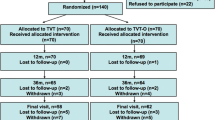Abstract
Introduction and hypothesis
The purpose of the study was to evaluate the efficacy of postoperative transvaginal tape mobilization (TM) in treating urinary retention after tension-free vaginal tape (TVT) procedures.
Methods
A 3-0 Vicryl loop was made at the midpoint of the vaginal tape for tension adjustment. If urinary retention occurred postoperatively, TM was applied in the ward under local anesthesia. The TM procedure could be repeated until the patient voided well.
Results
Of the 80 women, five (6.3%) patients who had to void with extreme strain or with urinary retention received TM on postoperative days 1∼3. It was successful immediately in four patients, and only one patient required repeated adjustment three times. None of these five patients had recurrent stress urinary incontinence (SUI) after tensioning off of the tape. Overall, 67 patients (84%) had been cured of SUI, and 13 (16%) patients had improvement of SUI 3 months after TVT operation.
Conclusion
TM is efficacious in treating voiding difficulty after the TVT procedure.

Similar content being viewed by others
References
Ulmsten U (2001) The basic understanding and clinical results of tension-free vaginal tape for stress urinary incontinence. Urology 40:269–273
Nilsson CG, Kuuva N, Falconer C, Rezapour M, Ulmsten U (2001) Long-term results of the tension-free vaginal tape (TVT) procedure for surgical treatment of female stress urinary incontinence. Int Urogynecol J Pelvic Floor Dysfunct 12(Suppl 2):S5–S8
Rardin CR, Rosenblatt PL, Kohli N, Miklos JR, Heit M, Lucente VR (2002) Release of tension-free vaginal tape for the treatment of refractory postoperative voiding dysfunction. Obstet Gynecol 100:898–902
Tamussino K, Hanzal E, Kolle D, Ralph G, Riss P (2001) The Austrian tension-free vaginal tape registry. Int Urogynecol J Pelvic Floor Dysfunct 12(Suppl 2):S28–S29
Klutke C, Siegel S, Carlin B, Paszkiewicz E, Kirkemo A, Klutke J (2001) Urinary retention after tension-free vaginal tape procedure: incidence and treatment. Urology 58:697–701
Karram MM, Segal JL, Vassallo BJ, Kleeman SD (2003) Complications and untoward effects of the tension-free vaginal tape procedure. Obstet Gynecol 101:929–932
Ward KL, Hilton P (2004) A prospective multicenter randomized trial of tension-free vaginal tape and colposuspension for primary urodynamic stress incontinence: two-year follow-up. Am J Obstet Gynecol 190:324–331
Vervest HA, Bisseling TM, Heintz AP, Schraffordt Koops SE (2007) The prevalence of voiding difficulty after TVT, its impact on quality of life, and related risk factors. Int Urogynecol J Pelvic Floor Dysfunct 18:173–182
Mishra VC, Mishra N, Karim OM, Motiwala HG (2005) Voiding dysfunction after tension-free vaginal tape: a conservative approach is often successful. Int Urogynecol J Pelvic Floor Dysfunct 16:210–214 discussion 4
Ulmsten U, Henriksson L, Johnson P, Varhos G (1996) An ambulatory surgical procedure under local anesthesia for treatment of female urinary incontinence. Int Urogynecol J Pelvic Floor Dysfunct 7:81–85 discussion 5–6
Cetinel B, Demirkesen O (2005) Risk factors influencing the complication rates of tension-free vaginal tape-type procedures. Curr Opin Obstet Gynecol 17:530–534
Hong B, Park S, Kim HS, Choo MS (2003) Factors predictive of urinary retention after a tension-free vaginal tape procedure for female stress urinary incontinence. J Urol 170:852–856
Minassian VA, Al-Badr A, Drutz HP, Lovatsis D (2004) Tension-free vaginal tape, Burch, and slings: are there predictors for early postoperative voiding dysfunction? Int Urogynecol J Pelvic Floor Dysfunct 15:183–187
Wang KH, Wang KH, Neimark M, Davila GW (2002) Voiding dysfunction following TVT procedure. Int Urogynecol J Pelvic Floor Dysfunct 13:353–357 discussion 8
Ghoniem G, Shaaban A (1994) Sub-urethral slings for the treatment of stress incontinence. Int Urogynecol J 5:228–239
Nguyen JN (2005) Tape mobilization for urinary retention after tension-free vaginal tape procedures. Urology 66:523–526
Glavind K, Glavind E (2007) Treatment of prolonged voiding dysfunction after tension-free vaginal tape procedure. Acta Obstet Gynecol Scand 86:357–360
Murphy M, Culligan PJ, Arce CM, Graham CA, Blackwell L, Heit MH (2005) Is the cough-stress test necessary when placing the tension-free vaginal tape? Obstet Gynecol 105:319–324
Takacs P, Medina CA (2007) Tension-free vaginal tape: poor intraoperative cough test as a predictor of postoperative urinary retention. Int Urogynecol J Pelvic Floor Dysfunct 18:1445–1447
Nichols D, Randall C (1996) Choice of operation for urinary stress incontinence. In: Nichols D, Randall C (eds) Vaginal surgery, 4th edn. Williams & Wilkins, Baltimore, pp 384–421
Maroto JR, Gorraiz MO, Chaparro LP, Bru JJ, Bueno JJ, Lopez CL (2008) Transvaginal adjustable tape: an adjustable mesh for surgical treatment of female stress urinary incontinence. Int Urogynecol J Pelvic Floor Dysfunct 19:1109–1116
Maroto JR, Gorraiz MO, Bueno JJ, Perez LG, Bru JJ, Chaparro LP (2009) Transobturator adjustable tape (TOA) permits to correct postoperatively the tension applied in stress incontinence surgery. Int Urogynecol J Pelvic Floor Dysfunct 20:797–805
Vassallo BJ, Kleeman SD, Segal J, Karram MM (2003) Urethral erosion of a tension-free vaginal tape. Obstet Gynecol 101:1055–1058
Conflicts of interest
None.
Author information
Authors and Affiliations
Corresponding author
Rights and permissions
About this article
Cite this article
Chang, WC., Sheu, BC., Huang, SC. et al. Postoperative transvaginal tape mobilization in preventing voiding difficulty after tension-free vaginal tape procedures. Int Urogynecol J 21, 229–233 (2010). https://doi.org/10.1007/s00192-009-1016-5
Received:
Accepted:
Published:
Issue Date:
DOI: https://doi.org/10.1007/s00192-009-1016-5



